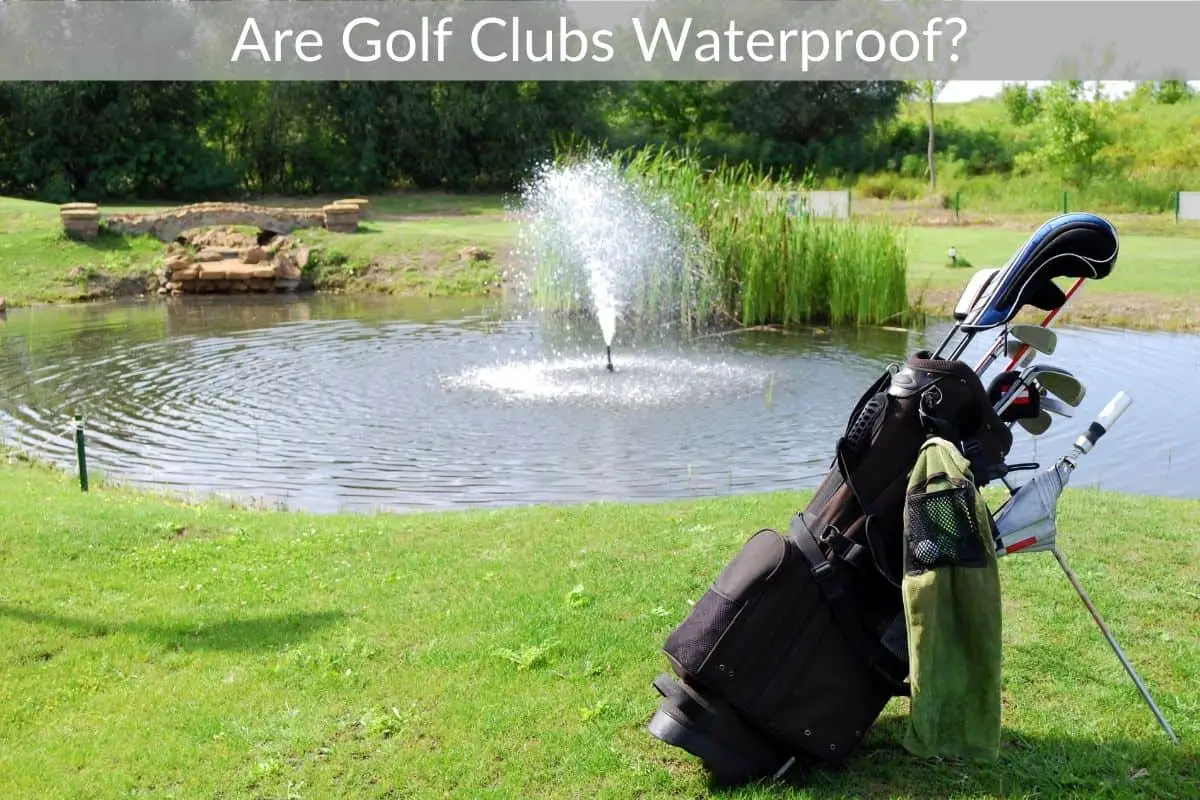Table of Contents
*This post may contain affiliate links. As an Amazon Associate we earn from qualifying purchases.
Whether it’s rain or you just found yourself having to make a shot from near the water sprinkler, almost everyone ends up getting themselves (and their gear) wet at one point or another while golfing. There are several considerations to make when buying clubs, and whether or not they are waterproof (or even water-resistant) is a very important factor to consider.
There is no such thing as a waterproof golf club, unfortunately. There are water-resistant golf clubs with a non-polar coating around them, which repels water, preventing it from settling and giving room to rust.
However, even these golf clubs need to be wiped before you put them in the golf bag.
In this article, I will take a closer look at how you can prolong your golf clubs’ life when they come into contact with water. This is especially important if you live in a rainy area of the country.
To see some of the latest and greatest golfing gadgets currently on the market just click here.
Are Golf Clubs Waterproof?
If you are particularly sensitive about protecting your golf clubs from water, you are not alone. Although the problem is more prevalent for you if you are in a rainy or humid area, dry environments also present a similar issue because of the numerous sprinklers placed throughout the course.
A prime solution seems to be waterproof golf clubs, golf bags, and almost every other piece of equipment, but unfortunately, there is no such luxury.
Instead, manufacturers apply a non-polar coating that repels water (since water is a polar substance).
You will see small, round droplets trailing down your club if the coating is still good. If the coating has worn off, though, the water droplets won’t be as uniformly round and create long streaks as they ‘crawl’ downwards.
You can always re-coat your golf club with any non-polar substance around the house, such as Vaseline or even motor oil (use as little as possible, but enough to give you a complete coat), but be very careful with the coat.
If the coat is too thin or not uniform, the water won’t flow properly and find its way into the layer, which is worse in every sense of the word. However, if the coat is too thick, you will start seeing smudges on your club, which isn’t aesthetically pleasing.
The club may also start slipping as you play your shot, resulting in fall damage if you aren’t careful or a poor shot.
There are waterproof bags, though, that can keep your clubs and other golfing gear dry, but of course, this won’t help you much when you pull the club out to play.
Do Water-Resistant Golf Clubs Cost More?
Water-resistant golf clubs won’t cost you a penny more. Industry standards recommend that every manufacturer puts on this layer of protection to their golf clubs, but it is important to note that it isn’t required.
Cheaper golf clubs aren’t coated and, therefore, may not last as long if rust starts to settle.
What Does Water-Resistant Golf Clubs Mean?
Water-resistant and waterproof don’t mean the same thing. Where waterproofing means that your equipment will stay dry, even if you submerge it in a pond, water resistance means that the club will resist water ingress into and on its body.
It will keep the club dry in light moisture conditions and resist water damage even during heavier rains. Still, if completely submerged, water will find its way into the club’s metal body.
Leaving a waterproof club submerged in water will not damage the club in any way, but water-resistant clubs will start getting damaged if submerged.
Furthermore, waterproof clubs can block moisture from soaking through completely, while water resistance only reduces the degree of water that gets through its outer membrane or laminate.
To ensure that your water-resistant golf club remains in good condition and doesn’t soak in any damage from water, pull the club out and play your shot as slow as you need to but as fast as you can.
Once done, wipe away the excess water (under the golf cart’s roof or in any other dry area, if possible) and put it back into your preferably water-resistant golf bag.
As you wipe down your club, after some time, you will notice that the smooth, round droplets that the club used to create and the trickle-down rate start diminishing. This happens because a small portion of the protective layer will be wiped away each time you clean the club.
You can either send the club back to the manufacturer or apply any other non-polar substance on your golf club to make it water-resistant again.
Simply:
- Use a soft, lint-free rag and clean your club for any debris. Make sure there is no dust anywhere before you start applying the layer.
- Take any substance that you want to rub on the club. There are some dedicated ‘waterproofing’ agents that you can use, but if you are testing the theory out, use Vaseline or any oil around the house. Do your research first to ensure it doesn’t hurt metals.
- Apply a bit on the shaft first and spread it uniformly over it. If you have reason to believe that you missed a spot, I recommend starting from scratch instead of doubling up and risking an uneven coat.
- Move on to the head. I recommend blotting the substance on the seams or the texture and pushing it in with force. When you are certain that the texture is filled with the substance, spread the remaining around the rest of the body.
I would recommend you don’t apply these products on the grip as it can make the club slippery. Instead, there are waterproof grips available on almost every golf supply store. - And finally, go a few rounds with the club before you start playing with it. Let the head rub against the grass a few times so that the excess can be removed. All you need is a single, uniform layer.
And that’s it. Depending on the compound you used, and how roughly you use the club, the coat can last anywhere between a week and a few months. Motor or cooking oils, for example, will only last a week at most.
Vaseline can stick around longer, but it’s not the most optimal solution either. I would recommend going with a dedicated waterproofing compound instead.

